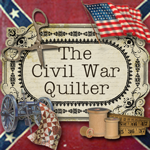The New Year is here already! I will never get everything done that I dream of doing if time doesn't cooperate and slow down!
I spent hours browsing the Internet New Year's Eve for quilt history nuggets and somehow 4 days slipped by without my hardly noticing!
I found an unusual quilt on eBay whose triangles seem to be held together by what the seller is calling "tatting". Click on the photos to enlarge them.
 (photo courtesy of eBay seller)
(photo courtesy of eBay seller)When I posted the link on the Quilt History List a friend posted that she thinks it is "faggoting, not tatting" and gave me a great link to see the process.
AQSG member Barb Garrett wrote: While I've seen puff quilts like this where the "puffs" are sewn together using a whip stitch, this is the first time I've seen one with the triangles attached in this manner.
I however would disagree with the seller. From what I can see in the picture, I don't think this is either a tatting or crochet stitch. I think it's faggoting, specifically Twisted Faggoting. Using google, I found a definition --
*Faggot Stitches* Faggoting is both useful and quite beautiful. It is used in joining of two pieces of material by means of an insertion stitch.
I also found pictures -- I also found pictures. Go to end of this article to see sketches B 1 and B2 of Twisted Faggoting --

The quilts (comforters) I've seen made from this technique (fold a square diagonally in half, stuff with some batting and sew the edges, then attach the triangles) have either been that shiny slippery 1920s fabric, or cottons. My most recent sighting was made using 1950s fabrics.
However, Newbie Richardson, a costume & textile specialist, had this to say about the connecting stitches:
The coverlet under discussion - the one with the thread joining the triangles - is made using an "open hem stitch" to join the fabrics. It looks like a feather stitch - but when the stitch is done to join fabrics, it is called hem stitching. Faggoting - a close cousin - has lines of thread that are perpendicular to the fabric, this stitch is going diagonally across and twisting.

We usually see these kinds of stitches done on really nice linen blouses from the 1930's and 40's. They are used in the seams to join the sleeves to the armhole, or the placket to the fronts, etc. I found it on page 182-183 of Caulfield and Saward's "Dictionary of Needlework". However, it may be a question of nomenclature. The site Barb referrenced showed "bar fagotting" -and that could be it too. I have looked for that stich in a few of my books - but no luck. So it seems a question of vocabulary. Remember, most embroidery stitches are variations on a theme and depend on whether the needle goes under or over the thread, etc.
Barb just sent me some additional information about a form of quilting that is called "Stuff and Puff Quilts" that is a somewhat similar method. She writes:
This book, Stuff 'n' Puff Quilts, copyright 1976, describes on page 36 how to make the puffs -- "Cut square using template. Fold along dotted lines (picture of diagonal), to form triangle."
On page 3 they give 2 options for joining puffs -- "Hold or pin 2 puffs closely together. Overcast edges of each puff together using a double strand of quilting thread." The other choice -- "If desired all units may be joined on the sewing machine using a close zig zag stitch in a contrasting or harmonizing color thread."
The book includes patterns and directions for making many different designs using this "make puffs and sew them together" method.
Never having done either form of needlework, I wouldn't have been able to tell the difference myself. Thanks, Barb and Newbie, for sharing!
Now to share a photo with you of a new Signature Quilt top I acquired recently. I'll tell you more about it in my next post. It is probably from New Jersey.

Have a Wonderful New Year!
Karen
Resources: The three photos of the "quilt" in question are all courtesy of the ebay seller.
To contact me click here.







Terrific information. I am the person that posted the quilt on e-Bay. I had never seen anything like that. I am also an avid crocheter and did not feel it was crocheting, so came up with the tatting explanation. I have never heard of faggoting, so this has been very interesting to read about.
ReplyDeleteThank you, Peggy, for visiting!
ReplyDelete